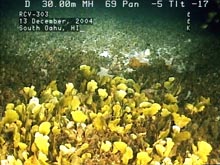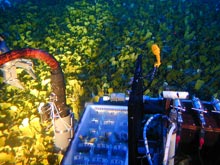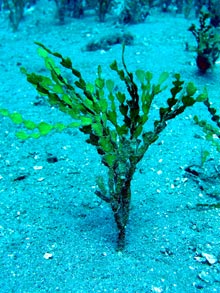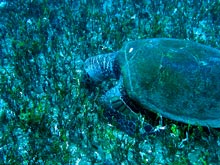
Deep water meadows of the dark green alga Avrainvillea amadelpha (background) and light green calcified Udotea sp. (foreground). This picture was taken by the Remotely Operated Vehicle. Click image for larger view.
An individual Halimeda kanaloana. Note the green calcified segments and surrounding sand of decomposing segments. Click image for larger view.
Algal Meadows in Hawaii:
Gardens of the Deep
Heather Spalding
Chief Scientist and Graduate Student
University of Hawaii at Manoa
In some tropical marine environments, algae (limu, or seaweed) form dense, monospecific (single-species) assemblages over sand or rock. Similar to their counterpart plants on land, these assemblages are often called meadows. In the clear waters of Hawaii, light is able to penetrate to depths greater than 200 m, allowing algal meadows using this light for photosynthesis to occur deep into the photic zone (water depth with enough light for photosynthesis to occur). Our study was the first to explore areas of Hawaii likely to contain algal meadows, and our goals were to determine their species composition, abundance, lower depth limits, and associated organisms.
Our deep water algae surveys in Hawaii revealed different types of algal meadows, including meadows of the calcified green algae Halimeda kanaloana, Udotea sp., and the dark green alga Avrainvillea amadelpha. Our survey provided the first description of the genus Udotea in Hawaii off of south Oahu over sand, and the first report of deep water meadows of Avrainvillea. Avrainvillea is typically described as an invasive green alga found in shallow water in Hawaii; little was previously known about its distribution in deep water. The discovery of these undescribed dense meadows highlights how much we have yet to learn about the dim-lit gardens of Hawaii's deep waters.
Algal meadows are typically composed of green algae belonging to the order Caulerpales (Chlorophyta), such as the calcified genus Halimeda. Halimeda are among the most abundant algae in tropical habitats, and are easily recognized by their plate-like calcified segments, resembling green buttons. These are joined together by small, uncalcified nodes into branching chains, to produce a more or less bushy plant. Halimeda kanaloana meadows were found growing in sand from 20 to 90 m depths throughout the islands of Moloka'i, Lana'i, Maui, and Kaho'olawe (or the Maui Nui island complex), while meadows of Halimeda distorta (tentative identification) were found throughout Oahu and Maui Nui growing over rock from 60 to 150 m depths.
Halimeda grows new segments while shedding old segments like leaves from deciduous trees. These shed segments decompose to eventually become carbonate sediment, or sand. Halimeda are important producers of carbonate sediment on coral reefs and in nearby lagoons, often producing more sediment than the reef framework itself! High sand production by Halimeda can be related to the plants rapid growth rates. A single plant has been reported to produce 359 new segments in 68 days (Drew 1983)! We are using on-going studies of Halimeda growth from different depths, combined with distribution and abundance data from submersible and ROV surveys, to model the quantity of sand produced by Halimeda meadows in Hawaii.

Dense Udotea sp. meadows at 65 m depth. Small fish were observed with the submersible and divers using the leafy blades of Udotea sp. and the bushy canopy of Halimeda kanaloana as refuge. Click image for larger view.
A turtle eating Halimeda kanaloana at 30 m depth. This turtle has been observed in the same meadow numerous times over the past year. Click image for larger view.
Deep water algal meadows appear to play an important role in the ecology of some tropical coastal ecosystems. The low, lush vegetation of algal meadows creates structure on other-wise featureless expanses of sand. Structure is used as a habitat or settling substrate for marine flora and fauna or as a food source. Small fish were observed with the submersible and divers using the leafy blades of Udotea sp. and the bushy canopy of Halimeda kanaloana as refuge.
Numerous species of algal epiphytes and invertebrates, such as urchins, crabs, shrimps, brittle stars, bryozoans, and encrusting sponges, were found growing directly on the algae. Although Halimeda is considered inedible due to anti-herbivory compounds and its high levels of calcium carbonate, fish and turtles were observed grazing on Halimeda plants. Further studies are needed to determine if deep water Halimeda or other algal species are an important part of their diet in Hawai'i.
In Hawai'i, expansive forests of the tree Ohi'a (Metrosideros) span from the mountain tops to the coastal plains. Similarly, we now know that dense meadows of marine plant life can extend from the ocean's edge to the limits of the photic zone in Hawai'i. Algal meadows can be formed from a diverse array of species, and appear to be an important part of the coastal ecosystem.
For information on Halimeda meadows in Australia, refer to the Australian Institute of Marine Science website. ![]()








